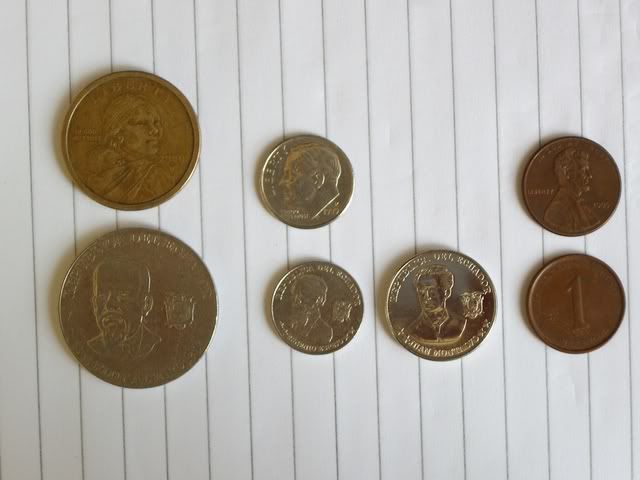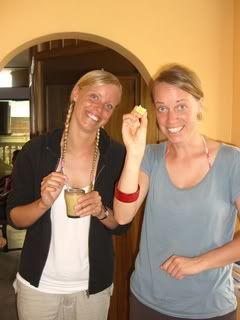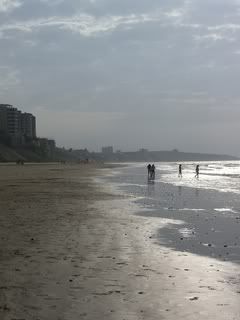Ecuador 4 – Dinero

First up: a housekeeping item. For those of you joining the Extravaganza from the Bootsnall website, be sure to check out the newly added section of “South America Reviews” under the Categories heading…I´ll also be posting the same information under “Trip Info” in the Pages section. I´ll be adding reviews of various accomodations, tour operators, language courses, volunteer programs, etc. as I experience them. I´m not one for restaurant recommendations really but if I eat somewhere truly amazing I´ll add it. For my “normal” readers (and I use that term very loosely as some of you are far from normal)…feel free to skip any post that starts with “Review” as you probably won´t find much of interest in it. Also…still sucking on the picture taking but there´s not too much that´s scenic here in Manta so there will be a hodgpodge of pictures in this post. I´m headed to the beach tomorrow morning for the weekend though so hope to do better with the camera this week.
Vamos a ver…dinero. Money. Cash. An issue on the minds of most people at any given point in time and here in Ecuador an issue of some confusion so I´ve decided to devote this post to explaining some issues surrounding the current financial situation. I realize that I´m one of the very few who find macroeconomic principles to be interesting so I won´t be offended if those who are not interested just skip right over this post. I´ve received several questions about this though so I think it´s worth mentioning what I´ve come up with for an explanation.
Back in the comments of Ecuador – 2, Faye did us a favor (thanks Faye) and gave us a brief synopsis of what happened when Ecuador started using the U.S. dollar as their official currency, a process officially referred to as “dollarization” (though the term dollarization is not only applied to usage of the United States dollar, but also generally to the use of any foreign currency as the national currency. As of August 2005, the United States dollar, the Euro, the New Zealand dollar, the Turkish new lira, the Russian ruble, the Swiss franc, the Indian rupee and the Australian dollar were the only currencies used by other countries for official dollarization.) As Faye mentioned, the U.S. dollar was introduced in Ecuador in response to a major financial crisis. Excellent. What does that mean exactly?
With significant apologies to Alan Greenspan for oversimplifying the economics behind this, I have discovered there are three major reasons that a developing country might want to dollarize:
- Rampant inflation caused by excessive printing of a national currency can be stopped by introducing a stable currency with sound economic policy (exit Ecuador´s sucres…enter U.S.$)
- Stabilized inflation leads to a stabilized general economy which in turn sustains the buying power of the Ecuadorian people and allows the nation to experience economic growth without the added worry of currency value fluctuations.
- Long-term economic planning is easier to do (eg. taking out long-term business development loans) because a interest rates and currency values are less likely to fluctuate. An example: a hotel-owner is able to obtain a loan for a new van and thus expand his touring business. Also, foreign investors are more likely to invest in a place where inflation risk is lower and economic and monetary problems are lessened.

OK, so I don´t think it´s much of a strech for us to understand why Ecuador might want to adopt the U.S. dollar (or rather the government would….it´s up for debate if the people of Ecuador are for it). But why in the world would the United States government ever agree to this? Here are a couple of answers to that question:
- 1. It is estimated that 55-70% of the $480 billion in U.S. currency in existence today already circulates outside of the U.S. So, most of the money isn´t even in the U.S. in the first place…the U.S. Treasury barely notices when a country dollarizes as the dollar has likely already been in heavy circulation in that country anyway. For example, most bank deposits and investments in Peru and Bolivia take place in U.S. dollars even though those countries have their own currencies. Peru´s ATMs even give you the option of dispensing dollars or Peruvian soles.
- 2. As it turns out, the U.S. Treasury also doesn´t mind printing extra money because they make money every time they print a new bill (that is not used to replace an old one). Here´s everyone´s (including my) new word for the week: seigniorage. For the United States, dollarization means foreigners will demand even more dollars than the large amounts

they use now. The United States would have to print more money to meet the increased demand but would benefit from increased seigniorage. Seigniorage is the profit a government makes from printing money. For example, it costs three cents to print a $100 bill but that bill buys $100 worth of goods. When they dollarize, countries allow the United States to earn seigniorage rather than earning it for themselves. Now of course, Ecuador is also giving up its ability to institute their own monetary policy as they are now at the mercy of the Fed thousands of miles away in Washington, D.C.
One thing that is still a little hazy to me is the logistics of the switch. I highly doubt the U.S. Treasury said “Hey, sure Ecuador. Hand over your worthless Sucres and we´ll give you millions of dollars in return.” One source I read said the following happened:
“When Ecuador made the switch–it did notify the United States of its intention–the country swapped $400 million in U.S. Treasuries and other assets for cash through a Miami bank and had the whole caboodle flown down. Most countries that switch continue to mint their own coins, however. Coins make up less than 10% of circulating currency, and shipping costs of U.S. coins are prohibitive.”
Another source said Ecuador had to hand over all of their gold reserves…still another said Ecuador exchanged their oil reserves. Who knows really?
This might be a good time to clarify that Ecuador prints its own coins (though you can still use regular U.S. coins) with its own dead famous people…and while Ecuadorian coins have the same value as a U.S. coin they are still only legal tender in Ecuador. The picture above shows what I´m talking about (I didn´t have a quarter)…the Ecuadorian coins are the same size and color as U.S. coins but with different people on them. Note the existence of the Sacajawea golden dollar? Those have almost ceased to circulate in the U.S. but after the initial minting, 500 million of them were shipped to Ecuador where they are in heavy circulation.

Yikes, this got a little longer and more complicated than I intended so I guess I´ll leave out the rest of what I had planned for today. Lots more time here in Ecuador (and the rest of the continent) so we´ll get to it all in due time. I hope that helped slightly. If anyone´s dying to learn more and wants the list of links I used…send me an e-mail. Hasta luego…
Pictures: (1) The girls are Hannah and Clara…Swedish girls I met in Quito who were also planning to come to Manta. They´re learning to kite-surf…hich is exactly as it sounds…surfing while attached to a kite. (2) Wyatt, from Alaska…college student in Utah. He´s getting the international experience he needs for his degree here in Manta.
Tags: 8 - Ecuador, economics, money

October 26th, 2007 at 10:43 pm
Very interesting economics lesson today, Stacey. It took some doing for me to wrap my brain around that on this exciting Friday night at the Barnum house….on the upside, the Schmidters are coming over for dinner tomorrow! And it is so funny that those girls are from Sweden because that is EXACTLY what I thought when I saw the picture!
Toodles,
Andrea
October 27th, 2007 at 12:43 pm
My first lesson on economics. Thanks Stace!
October 30th, 2007 at 8:44 am
Yes, the economics lesson was good. You would be wise to gather up a few of the Sacajawea dollars and bring them back. We don’t see them here much. I am also interested in the beach scene. That is beautiful! What time of day was that? Because you are so close to the equater (or are you?) That had to have been pretty late at night.